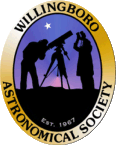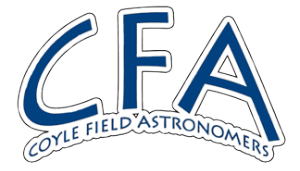Partial Solar Eclipse at Sunrise
Here's the sun at 6:31:23 am EST on November 3, 2013, a few minutes after sunrise at 6:28 am, as seen from the promenade along the Atlantic Ocean beach at 14th Street North in Brigantine, NJ. The sun, of course, is in partial eclipse by the moon, which is the darkened circular bite out of the bottom of the sun. Taken with a Canon 6D digital SLR camera at the prime focus of a William Optics 80 mm f/6 apochromatic refractor on a fixed tripod. Exposed 1/1000 second at ISO 100 with no filter. The camera's clock was set by its internal GPS.
The sun (and the moon's silhouette) at 6:53:19 am EST. Same camera and scope, but now with a metalized glass filter in front of the objective. Exposed 1/250 second at ISO 1600, and cropped to enlarge the image. At the low altitude of the sun (which reached just 6.8° at the end of the eclipse), the seeing was not very crisp, so the edges of the disc were wavy and fluttering while the sunspots were a bit diffuse.
The sun (and the moon's remaining silhouette) at 7:05:58 am EST. Same camera, scope and filter. Exposed 1/500 second at ISO 400. Cropped.
The sun (and the last bit of the moon's silhouette) at 7:09:46 am EST, 53.5 seconds before last contact and the end of the eclipse at 7:10:39.5 am EST (calculated from the coordinates provided by the camera's GPS using the USNO's MICA software). Some more sunspots have been uncovered near the lower solar limb. Same camera, scope and filter. Exposed 1/500 second at ISO 400. Cropped.
The Planets at Longwood Gardens
During a visit to Longwood Gardens on October 27, 2013, we made the usual tour of the Pierre S. du Pont house. Here's a view of his office looking at one of the bookshelf/storage cabinets. Notice the illustration of the planets towards the upper-right corner of the bookshelf. It's titled "Relative Sizes of the Planets (At this scale the Sun is 6 ft in diameter.)" Canon 6D with Canon 24 to 105 f/4L zoom lens at 24 mm focal length; exposed 1/30 second, f/4.5, ISO 640 (handheld with stabilization on). Taken at 2:32 pm EDT.
Here's a close-up of the illustration. Same camera and lens, but set to 105 mm focal length (a railing prevents moving any closer); exposed 1/100 second at f/4.5, ISO 2500 (handheld with stabilization on). This image is cropped to about 56% of the original linear dimensions. Taken at 2:31 pm EDT.
Here's the same image as the above, but cropped to 15% of the original linear dimensions. Notice the names of the fifth, sixth and seventh satellites of Jupiter, and that satellite number 8 has been filled-in by hand.
The Earth's Shadow
The full moon is rising above the treetops as viewed from Boundary Creek Park in Moorestown, NJ, at 6:29 pm EDT on October 18, 2013. The darkened band of sky along the treetops is the earth's shadow, and above that is the pinkish Belt of Venus, illumination by reddish light from the just-set sun refracted by the earth's atmosphere. The shadow is not just in our local sky, it also extends beyond the moon, which is crossing the faint outer portion of the shadow cone during a penumbral lunar eclipse that reached a maximum of 76.5% lunar immersion at 7:50 pm EDT. However, even at maximum, the darkening induced by this eclipse was barely visible. Exact full moon was at 7:38 pm EDT, not the same time as mid-eclipse because the moon's path is tilted 5° relative to the ecliptic.
LADEE Launches from Wallops Island
On September 6, 2013, NASA launched a Minotaur V rocket from Wallops Island, VA, carrying the LADEE spacecraft on a mission to the Moon. This is the view from East Point, NJ, looking over the Delaware Bay. It was time-stamped at 11:27:29 pm EDT, just after the rocket emerged from a glowing bulge at the horizon, slightly west of south (due south is the short dark span on the horizon, between the glow from Cape May, NJ, on the left and Lewes, DE, on the right). It was taken with a Canon 6D digital SLR camera (on a fixed tripod) and a Canon 24-105 mm F/4L zoom lens set to 24 mm focal length. Exposed 15 seconds at f/5.6, ISO 3,200. Note: The camera's clock was 5 seconds slow as determined by comparison to the USNO's web clock after arriving home after the launch. The times listed here have been corrected by adding 5 seconds. Also note that there are many aircraft streaks in these photos, a prominent one at the top of this one.
The view time-stamped at 11:27:48 pm EDT. Same camera and exposure as the first image, pointing in the same direction. There's an aircraft steak at the upper left.
The view time-stamped at 11:28:38 pm EDT. Same camera and exposure as the first image, pointing in the same direction. The rocket is the brightest streak, the rest are aircraft.
The view time-stamped at 11:29:56 pm EDT. Same camera and exposure as the first image, but now pointing roughly east, towards Sea Isle City on the Atlantic coast, about 18 miles away. The seawall along the Delaware Bay is on the right, and in the foreground, some of the crowd that had gathered to watch the launch (15 to 20 cars were there).
The smoke trail persisted for quite a while after the rocket disappeared in the east. This view was time-stamped at 11:35:01 pm EDT. Same camera and lens as before, but set to 67 mm focal length and exposed 8 seconds at ISO 12,800. The bright star below the smoke is Beta Ceti (Deneb Kaitos or Diphda).
Sunset over the Delaware Bay
Because of the beautiful weather on September 4, 2013, we took a trip to Cape May, NJ. On the way home, we stopped at Norburys Landing to watch the sunset over the Delaware Bay, and to look for Mercury, 11 days past superior conjunction. Alas, the low angle of the ecliptic after sunset this time of year precluded finding the winged messenger at this time (but greatest elongation isn't until October 9th, so there will be more opportunities). However, I had my camera and took some scenic snapshots. This one was captured at 7:12 pm EDT (13 minutes before sunset) with a tripod-mounted Canon EOS 6D digital SLR camera and a Canon 24-105 mm f/4L zoom lens set to 24 mm focal length. It was exposed (fully automatic) 1/250 second at f/11, ISO 100. Besides size reduction, no processing was applied.
This image was taken at 7:25 pm EDT, the moment of sunset. When magnified, just a tiny spot of the bright upper limb remains (disappointingly, no green flash was observed). Same camera, lens and tripod, but set to 105 mm focal length. Exposed 1/320 at f/7.1, ISO 100 (again, fully automatic with only size reduction applied).
Here's a severe crop, about 10% of the original linear dimensions (or about 1% by area), of an image taken at 7:24 pm with the same camera, lens, focal length and exposure as the previous image (and just a moment before it). Brightness has been reduced a bit to show the vague greenish color of the solar blip above the water line. The Green Flash?
Click here for some older images.



